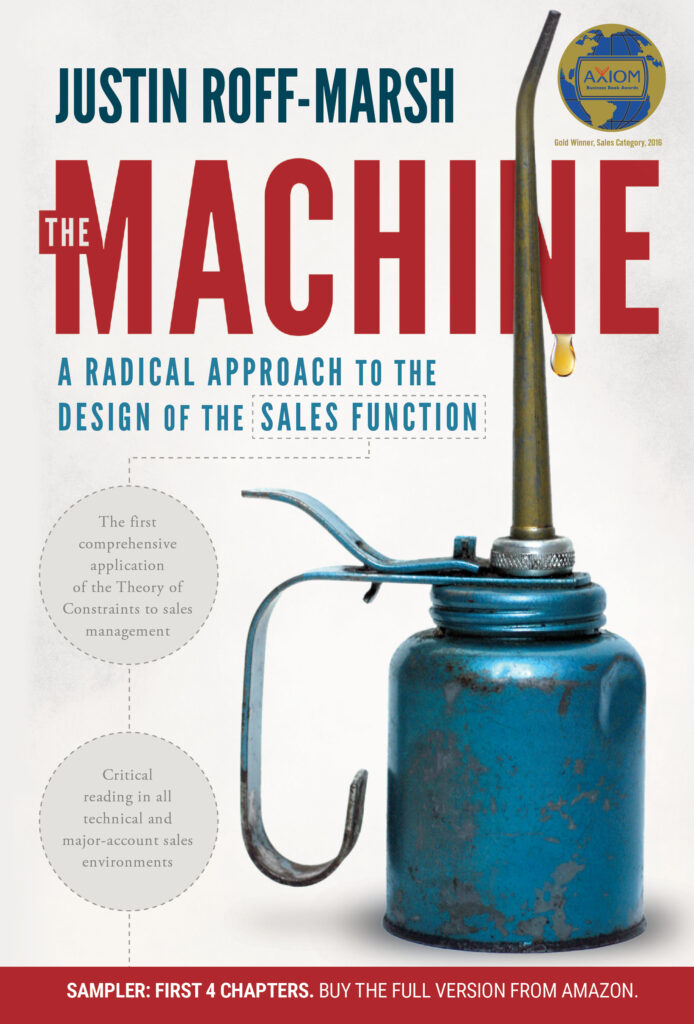
The Machine Sampler
The elusive nature of double-digit growth
And the simple design flaw that stops your industrial sales organization from achieving it!
This is an extract from an article written by Justin Roff-Marsh. If you enjoy it, then you should read Justin's book, The Machine. You can get the first four chapters in print or audio here for Free.
Most industrial businesses aim for double digit growth. But each year, because of a simple design flaw, we end up settling for single digits. Ignoring this flaw leads us to make four big mistakes that artificially handicap the growth of our organizations.
THIS is why your industrial organization is stuck on single-digit growth!
Truth #1. Salespeople do not generate revenue.
We still hold salespeople responsible for revenue. We even pay them commissions on that revenue. But the truth is salespeople no longer generate the revenue. Salespeople, when their effective, generate commercial relationships. And, as a result of these commercial relationships, they sell programs. It is these programs—not the initial sale—that generates the revenue.
Truth #2. Operations—not Sales—does generate revenue.
Revenue doesn’t come from the sales department; it comes from Operations. If you don’t believe this statement do this simple test. Make a list of the last 10 customers you lost. My guess is that they left because they were unhappy with your delivery performance, pricing or product range. Salespeople do not directly control any of these – Operations does!
Truth #3. Customer relationships are annuities
An annuity is a bundle of future revenue. From your bank’s perspective, the mortgage they sold you is an annuity. Because it’s inconvenient for your customers to change suppliers regularly, each of your customer relationships is an annuity. As long as Operations does a good job, sales does not need to get involved to manage that annuity.
Truth #4. The value of an account is inversely proportional to its cumulative spend
As the potential revenue of a new account is converted into actual revenue, the economic value of the account actually reduces. This means that an account is worth the most, the day it’s won—even though the account has not yet generated a single dollar in revenue.


Like this article? Subscribe now
Subscribe to Sales Process Engineering and receive each of Justin's posts, fresh in your inbox.
Ignoring these four truths leads us to make four big mistakes that artificially handicaps the growth of our organizations!
Even though they don’t directly influence it, and even though this distracts them from the pursuit of new business.
We pay our salespeople commission based on revenue, which focuses them, even more sharply, on exactly the set of behaviors we DON'T want them to engage in.
We put too few people in customer service and other important functions like design engineering and quoting based on the assumption that salespeople should be responsible for revenue.
As a consequence we underinvest in the growth of our industrial sales organizations.


Get the first four chapters of The Machine Free
Justin Roff-Marsh is author of The Machine: A Radical Approach to the Design of the Sales Function. You can get the first four chapters of The Machine in print or audio version for free here.
The design flaw and how to fix it
Fortunately, this problem is pretty easy to fix—in theory. (It’s a little more complicated in practice.) In theory, we begin by updating our starting assumption. We recognize that salespeople do not directly generate—and should not be held accountable for—revenue.
This means that Operations must accept responsibility for revenue—and this forces us to rethink the design of our organization.
1
Step 1: Make Operations responsible for revenue NOT Sales
You need to make Operations NOT Sales responsible for revenue to allow your sales department to focus on new business (selling programs) exclusively. But a word of warning. This requires enhancing Operations to manage account management tasks better and faster than what salespeople can do. This might mean a larger and more capable customer service team. It definitely means better integration of customer service with other departments like engineering, quoting, procurement, production and finance.
2
Step 2: Move Prospecting to Marketing
You then need to take what salespeople call prospecting and move it to the Marketing department. But in order to move prospecting to Marketing, you need to do three things. First, you need to change the relationship between the Marketing and Sales departments. Second, you need to redefine the concept of a sales lead to that of your competitors’ customers. And third, you need to insist that Marketing –NOT SALESPEOPLE—replenish the opportunity queues daily.
3
Step 3: Focus your salespeople on selling conversations 100% of their time
Freeing salespeople capacity is good but isn’t what really drives the needle. What really drives growth is the number of selling conversations your salespeople perform each day. It’s quite feasible for an organization to generate a 20X increase in the amount selling conversations salespeople perform each week if they are freed from all non-selling activities.
Be warned, these changes are not easy. But it’s necessary. It’s overdue. And the upside is significant—double digit growth, year on year!


Want to know more?
This article is a sample of the content you will read in Justin's book, The Machine.
What does the end result look like?
A larger, more capable customer service team
This team is designed to perform tasks at a faster rate and to a higher standard, relative to salespeople’s traditional performance
A robust and more productive sales team
Performing a magnitude of more selling conversations than their direct competitors in the pursuit of new business.
A focussed marketing team aligned with the needs of sales
This means that the marketing department has the ability to generate sales opportunities at a faster rate than salespeople can consume them. (Remember: we’ve changed the definition of an opportunity to make this possible.)
A sales model for double-digit growth
The redesign of your sales organization means you can now generate double-digit growth, year after year.
Make this year the last year you settle on single-digit growth!



Justin Roff-Marsh is a thought-leader in sales process design.
His book, The Machine, won the Axiom Books Gold Award in the sales category.
Get the first 4 chapters free
Liked this article? Subscribe now
Get The Machine sampler free the instant you subscribe! You'll also receive each of Justin's posts, fresh in your inbox.
Get the first four chapters of The Machine Free
This extract is a sample of the content you will learn in Justin's book, The Machine. Get the book's first four chapters in hard copy or on audio FREE.
Follow Justin on Youtube
Follow Justin on Youtube and get his one-minute Shorts. Each short shares a business growth idea for your industrial sales company.